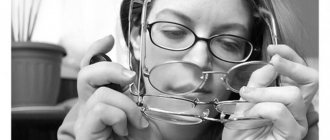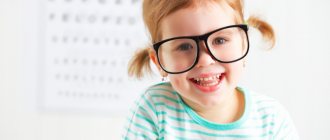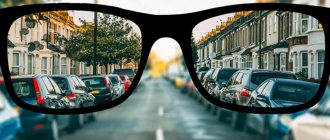Causes
The following reasons can lead to vision minus 5 diopters:
- Curvature of the eyeball: it lengthens somewhat, while light rays do not reach the retina during focusing.
- Excessively strong refraction of light rays.
- Unfavorable heredity. Poor vision is passed on genetically. The risk group includes people whose parents already have myopia.
- Weakness of accommodation, i.e. decreased ability of the eye to view objects located at close distances. Spasm of accommodation is the cause of pathological stretching of the eyeball.
- Failure to comply with visual hygiene rules. The risk group includes people who watch TV for a long time, work at a computer, or read in poor lighting conditions.
- Weakness of the sclera - the protein membrane. This condition leads to increased intraocular pressure and an increase in the size of the eyeball.
- Weakening of the body as a result of overwork, poor nutrition and other factors. This also occurs as a result of infectious, allergic pathologies, and disorders of the normal functioning of the musculoskeletal system.
- Some eye diseases, the most dangerous of which are glaucoma and cataracts.
- Diabetes. It causes damage to the small joints of the eye, causing vision to steadily deteriorate.
- Myopia develops as a result of an inactive lifestyle and due to excessive physical exertion.
What is myopia: “plus” or “minus”?
0
Myopia (myopia) is a serious problem that is associated not only with worsening vision, but also with an increased risk of complications. Myopic people find it difficult to perform many activities: driving a car, reading signs, information boards, and with a high degree of myopia, it is not easy to even see a familiar face at a distance of one or two meters.
According to the World Health Organization, up to 30% of the world's population suffers from this problem. The number of patients suffering from this myopia is steadily growing. Very often the disorder occurs in schoolchildren and students. People with good vision sometimes do not understand what myopia is: “plus” or “minus”? Let's look into this problem together.
What it is?
Myopia is a visual impairment in which a person has difficulty seeing objects located far away, but can clearly see objects that are very close. Nearsightedness is also called myopia.
One of the main components of the eye is the cornea and lens. They are able to transmit and refract rays of light. An image appears on the retina of the eye, which is transmitted through the optic nerve to the brain using nerve impulses.
If the cornea and lens refract the rays so that the focus is on the retina, then the image will be clear and vision will be one hundred percent.
With myopia, the image is blurry and unclear due to two abnormal factors:
- The eye is greatly elongated, and the retina moves away from the stable focus location. In people with myopia, the eye reaches 30 millimeters. And in a normal healthy person, the size of the eye is 23-24 mm.
- The lens and cornea refract light rays too much.
People with myopia have difficulty seeing objects that are far from them. But a myopic person sees objects close to the eyes well.
Causes
Myopia most often develops during school years. Heredity plays an important role in the development of pathology. It is important to consider whether one or both parents suffer from this disease. If both the father and mother have a disorder, then in 50% of cases it will also occur in the child before he or she comes of age. If the parents are healthy, then the risk of developing the disease is significantly reduced and is 8%.
Among the main factors contributing to the development of myopia are prolonged work at close distances under poor hygienic conditions or improper lighting. This reason is especially relevant today due to the widespread use of computers.
Distortion of the lens and reflection of objects
The development of myopia also contributes to weakening of the eye muscles. To solve this problem, special sets of physical exercises have been developed that can be used for both therapeutic and preventive purposes. Therapeutic eye exercises slow down the progression of myopia. Previously, ophthalmologists often recommended that myopic patients limit their physical activity. However, today the opinion of ophthalmologists has changed: moderate loads with a rational rest and sleep regime are recommended.
At a young age, myopia can be caused by:
- spasm of accommodation;
- keratoconus (change in the shape of the cornea);
- displacement of the lens due to injury (dislocation, subluxation);
- sclerosis of the lens.
The latter pathology leads to the development of myopia in old age.
There are other reasons that lead to the development of myopia:
- Lack of nutrients, vitamins, and minerals in the body. Vitamins B and C, as well as microelements such as magnesium, zinc, copper, and manganese, affect vision to a greater extent. All of them are necessary for the proper development and formation of the tissues of the sclera of the eye.
- Any eye strain caused by prolonged and continuous visual work.
- Lack of competent correction when the first symptoms of myopia appear. If the first signs of the disease are ignored, myopia will progress and lead to significant deterioration of vision.
- Incorrectly selected glasses or contact lenses for vision correction in case of early myopia.
- Congenital pathology (for example, weakness of the eye muscles responsible for changing the curvature of the lens).
- Some vision diseases (strabismus, astigmatism, etc.).
- Increased intracranial and intraocular pressure.
- All conditions that cause weakening of the body and disrupt the supply of nutrients to the eye (some infectious diseases, disruptions in the hormonal system, birth and traumatic brain injuries).
Symptoms
The main symptoms of myopia are:
- Fuzzy vision of distant objects;
- “flies” before the eyes;
- frequent headaches;
- rapid eye fatigue;
- splitting of objects;
- impaired twilight vision (in the dark, nearsighted people have difficulty driving a car and have poor orientation on the street);
- errors in color determination.
Depending on the degree of myopia, the patient's vision can vary from slight blurriness in the distance to complete blurriness even a few meters away.
Patients with a high degree of myopia see well literally right from the nose, but the further point of clear vision lies just a few centimeters from the eye.
Myopia can be combined with other visual diseases, such as astigmatism. Signs of this complicated form of the disease are:
- bifurcation of objects;
- distortion of objects;
- curved lines (instead of straight lines).
"Plus" or "minus"?
After studying visual acuity, all patients with refractive error undergo a trial vision correction using lenses. There are two types of lenses: diverging, denoted in ophthalmology by the sign “–” (minus), and converging, denoted by the sign “+” (plus).
Focus of the diverging lens
To correct myopia, diverging (“negative”) lenses are used. Thus, when they talk about glasses or lenses for correcting myopia, they always mean “minus” and not “plus”. But to correct farsightedness, “positive” or converging lenses are used, so farsightedness is a “plus”. What do the numbers mean, for example -2, -3.75 or any others?
The numbers indicate the optical power of the lenses needed for a patient with myopia to clearly see line 10 in Sivtsev’s table. Lens power is expressed in diopters and can have a fractional value. When writing out a prescription for glasses or contact lenses, each eye is given its own lens strength value.
There is such a thing as “false myopia,” which is not associated with changes in the eyes and is neither a “minus” nor a “plus.” This condition is caused by constant eye strain when working with nearby objects. False myopia can be treated with exercises and sometimes with medications, but does not require wearing glasses or contacts. In order not to confuse true myopia with false and not to purchase glasses in vain, it is necessary to immediately consult a doctor at the first signs of deterioration in vision.
The difference between a converging and diverging lens
A working method to restore vision! You will throw your glasses in the trash in just 3 days...
Restoring vision. Real life story.
Diagnostics
Only an ophthalmologist can identify the disease, determine the degree of myopia and choose the most appropriate treatment method for a given case.
Diagnosis of myopia requires the following studies:
- testing distance visual acuity without glasses;
- determination of refraction (refraction) of the eyes and the degree of myopia;
- choosing the right lenses;
- measuring eye length in an ultrasound room;
- measuring the thickness of the cornea at various points;
- examination of the fundus (will allow the doctor to assess the condition of the retina, blood vessels, optic nerve of each eye);
- selection of correction and treatment method.
Lack of myopia correction or incorrectly selected glasses (lenses) can lead to rapid deterioration of vision and the development of progressive myopia.
Treatment
Treatment of myopia is a complex process that can only be dealt with with the help of an ophthalmologist.
Modern methods of improving vision are varied:
Vision correction with glasses
- Laser correction.
- Optical correction of myopia.
- Methods of surgical intervention. Used when the disease is highly developed. It is possible to replace the lens with an intraocular lens and install an actual lens.
- Drug treatment of the disease.
- Correction of nutrition to improve blood supply to the eye and the supply of nutrients to it.
Laser vision correction for myopia
This is the most modern, safe and effective way to improve vision and get rid of the problem of myopia. Laser correction will allow the patient to stop wearing glasses and contact lenses. The essence of the intervention is to change the shape of the cornea, thereby reducing its optical power. Using a laser, it is possible to create the effect of wearing glasses, as if located inside the eyes, as a result of which light rays, after refraction in the lens, are focused on its retina.
Laser vision correction for myopia
There are several laser correction methods:
- LASIK (creation of corneal parameters using a template);
- Super LASIK (creation of individual cornea parameters);
- PRK (used for thin corneas and low myopia).
Each method has its own characteristics and is used depending on the condition of the eyes and the financial capabilities of the person.
Spectacle correction
Glasses are traditionally used to correct the vision of a patient suffering from myopia. They are equipped with diverging lenses, which weaken the optical system of the eye and push the image onto the retina. If myopia is complicated by astigmatism, you will need to wear glasses with cylinders.
Contact correction
Today, contact correction is gaining increasing popularity among young people. Contact lenses have a number of advantages over glasses. When properly selected and used, they provide clearer vision than glasses. Good lenses allow you to fully restore visual acuity without distortions and aberrations, which the best glasses cannot provide.
Complications
If myopia is not treated in a timely manner or corrected correctly, it may progress. Complications may occur such as:
- formation of scleral staphylomas (protrusion);
- retinal dystrophy;
- hemorrhages on the retina and vitreous body;
- cataract;
- retinal disinsertion.
Cataract as a consequence of advanced myopia
Complications due to myopia can occur at any age. In addition, destructive processes on the retina sometimes develop after surgical treatment of myopia due to the altered shape of the eye, which cannot be corrected.
In case of myopia (especially high degree), it is necessary to undergo regular examinations by an ophthalmologist, which will allow you to monitor the condition of the retina and make it possible to detect tears, holes, and thinning in time.
Prevention
Any disease is easier to prevent than to treat. Prevention of myopia involves the following measures:
- Adjusting the lighting mode. Visual stress is allowed only in good lighting using overhead light, a table lamp 60-100 W. Do not work under fluorescent lamps.
- Compliance with the regime of visual and physical activity. It is recommended to alternate visual strain with active, active rest: with myopia up to 3 diopters, physical activity is not limited; over 3 diopters, lifting weights, jumping and some types of competitions are prohibited.
- Gymnastics for the eyes (every 20-30 minutes).
- Correct vision correction prescribed by an ophthalmologist.
- Training of muscles, the tension of which leads to the growth of myopia (laser stimulation, video-computer vision correction, eye drops, special courses of eye gymnastics).
- Ophthalmological diagnostics: ultrasound measurement of the longitudinal size of the eye (once every six months).
- General strengthening measures (swimming, massage of the collar area, contrast shower) on the recommendation of an ophthalmologist.
- Complete balanced nutrition.
The first signs of eye glaucoma.
Farsightedness is a plus or a minus: https://eyesdocs.ru/zabolevaniya/gipermetropiya/opredelenie-dalnozorkosti-xarakternye-simptomy.html
How long to wear contact lenses: everything about the types and rules of use is written in this article.
Video
conclusions
So, myopia (hypermetropia) is a disease that must be treated in time to prevent progression and many complications. For myopia, wear minus lenses prescribed by your doctor. Impaired refraction of vision can lead to complete loss of vision, so its prevention and proper correction of myopia are extremely important. Read in more detail what vision minus 1 is.
Symptoms
The most typical symptoms of poor vision:
- inability to normally see objects that are located far away;
- feeling of pain in the head area;
- difficulty focusing while reading or looking at close objects, causing small objects to blur together, causing discomfort;
- a feeling of excessive compression in the eyeball area;
- blurred vision;
- significant decrease in peripheral vision.
Spinal disorders
A sharp deterioration in visual acuity can be caused by damage to the spine. Two arteries pass through the back areas, which are responsible for the blood supply to the head and eyes. Incorrect position of the spine impairs blood flow in the arteries of the back, which contributes to poor vision.
What to do? Do exercises for your back and neck regularly, and make sure your posture is correct.
Do not ignore vision problems, because by starting treatment earlier, you can prevent the development of serious eye problems.
How does a person with minus 5 vision see?
A person with such a visual disorder can only see close objects well. In the distance, all objects seem to be blurred and in fog. When myopia is combined with astigmatism, characteristic double vision of objects is observed, their contours are distorted. A straight line for such a person seems curved.
Finding yourself on the street without contact lenses or glasses, nearsighted people cannot distinguish faces even at a short distance. This feature of vision explains why a nearsighted person rarely greets someone first. This does not mean that he is ill-mannered: he simply does not see the person approaching him. It is easier for him to recognize an acquaintance only by the characteristic manner of movement, and not by the face and other signs that require clear vision.
For nearsighted people, it is difficult to see the bus number, which is why they experience serious problems. It's hard for them to see the price tag in the store. Reading is also difficult due to the fact that you need to hold the book very close.
Children also suffer from poor vision. They cannot see what is written on the board even from the first desk. If vision correction is not carried out, academic performance suffers.
You can imagine how a person with vision of minus 5 diopters sees the world by wearing glasses with the corresponding positive refraction.
The following photos give an idea of how a person with a refractive error of -5 diopters sees the world around him.
Points plus minus: which ones to choose
Many parameters need to be taken into account so that the eyes do not visually appear enlarged or reduced. Medical professionals in our salons will advise which product is best to choose. It is also worth considering the material of the frames:
- metal, titanium or alloys withstand wear well;
In our showrooms in Rostov-on-Don, classic models are presented by Tommy Fashion T10074, Megapolis 748 Gold, etc. Popular options are Vogue VO 4027-BC - semi-rimless, where the metal is located only in the upper part.
- plastic frame – different scale of prices, types, colors;
Plastic models are presented in our stores by different brands. For example, we offer multi-colored Glory 006 Green, Megapolis 2020 Red, etc.
- combination of plastic and metal.
Many are interested in a reasonable compromise - options that combine plastic + metal: Sameir 52030 C2, Sameir 51122 C3, etc.
In our chain stores there are many models that will highlight your style and individuality. Competent medical professionals will check your vision free of charge and help you choose glasses that will highlight your advantages and mask your disadvantages.
Treatment
Moderate myopia requires making some adjustments to the patient’s lifestyle. The most important and important restriction is that he should not lift heavy objects or make sudden movements. When working visually, you need to rest periodically, completely relaxing your eyes. It is useful to walk in the fresh air and perform special exercises to strengthen the ciliary muscle.
Correcting vision with glasses or contact lenses is not a treatment because it does not permanently improve vision. To combat myopia, hardware, medication, and surgical treatment are used.
Operations
To get rid of myopia, scleroplasty and laser treatment are used. As myopia progresses, scleroplasty is sometimes used. Most clinics in the world refuse it in favor of laser vision correction due to the high risk of complications.
Laser vision correction restores good vision to the patient. Only a small number of people are refused therapy due to malignant myopia or corneal thinness. Laser correction is associated with a large number of postoperative complications:
- halo effect;
- secondary keratoconus;
- formation of a cataract.
Drug treatment of myopia
For the purpose of drug treatment, the patient will be prescribed mydriatics, vitamins and vascular agents. Among the medications that dilate the pupil, the most commonly used are Tropicamide and Irifrin. Atropine sulfate is practically not used today. The main task of mydriatics is to relieve spasm of accommodation.
The most commonly used vitamin and vascular products are Okuvayt, Okuvayt lutein, Emoxipin, Taufon and others. The use of these products improves the trophism of the eye tissues and increases the microcirculation of the eye.
Hardware therapy
The use of devices to improve vision complements drug treatment and makes it more effective. The degree of vision improvement reaches 3 diopters or even more in some patients. Stationary and household devices are used to improve vision.
The use of hardware treatment in the clinic is sometimes not justified due to the fact that it is too expensive. Attending clinics at set times may be inconvenient for the client.
Hardware treatment at home is more acceptable and is the optimal choice for a patient with vision of minus 5 diopters. Thanks to the introduction of modern technologies, portable devices are used. One of them is a device for light pulse therapy such as Svetodar.
Its action is based on the principle of exposure of the eye to light rays of different lengths.
Clinical studies prove that daily treatment sessions using the Svetodar device stop the progression of myopia in children and adults. The device works as a stimulator and as a vision trainer. Short wellness sessions help fight eye fatigue after visual stress.
What it is
Minus 2 is a visual acuity parameter characteristic of myopia (myopia).
This is a fairly common disease, which affects approximately 800 million people on the planet to one degree or another (according to the latest data from the health organization). With it, the image is fixed not on a certain area of the retina, as in healthy people, but in the space in front of it.
For this reason, a person suffering from this pathology usually sees nearby objects well, but often has difficulty distinguishing objects located in the distance.
In medicine, there are three degrees of myopia:
- Weak (up to 3 diopters);
- Medium (3-6 diopters);
- Strong (from 6 diopters or more).
If the reading is -2, the doctor diagnoses a mild degree of myopia. With it, the patient does not necessarily have to constantly wear glasses or lenses to correct vision. His visual acuity is sufficient to distinguish objects around him, navigate in space, read, write, but there is a need for glasses to work at the computer. At this stage of the disease, the decrease in comfort of life is insignificant. In addition, it is quite easily corrected with both lenses and laser.
Despite the fact that mild myopia, as a rule, does not cause significant concern in a person and over time he can even get used to it, the disease should be treated with due concern. After all, it can progress very quickly and develop into a more complex form, which will be much less responsive to treatment.
It is for this reason that you need to be able to promptly recognize the disease even at this stage, and if you have a specialist’s report on hand confirming such a deplorable state of vision, you must immediately decide on methods to stop the progress of myopia and effective vision correction. Fortunately, today medicine has the necessary means for this.
Prevention
Prevention includes the following activities:
- maintaining a balanced diet with the obligatory inclusion in the diet of foods containing vitamins A, B, E, PP and microelements - zinc, copper, selenium;
- compliance with the rules of visual hygiene - limiting work with a computer, smartphone and other gadgets;
- competent selection of the level of illumination of the workplace when performing visual work;
- training the ciliary muscles to prevent the progression of myopia;
- protecting your eyes from harmful ultraviolet radiation - wearing glasses, using lenses while working with a computer.
Useful video
The following links to the video introduce how a myopic person sees the world around them and how normal vision can be restored:
Myopia minus 5 can be easily corrected with glasses or lenses. Timely consultation with a doctor helps normalize vision and restore the ability to clearly see the world around you.
Author's rating
Author of the article
Alexandrova O.M.
Articles written
2031
about the author
Was the article helpful?
Rate the material on a five-point scale!
( 3 ratings, average: 4.67 out of 5)
If you have any questions or want to share your opinion or experience, write a comment below.











